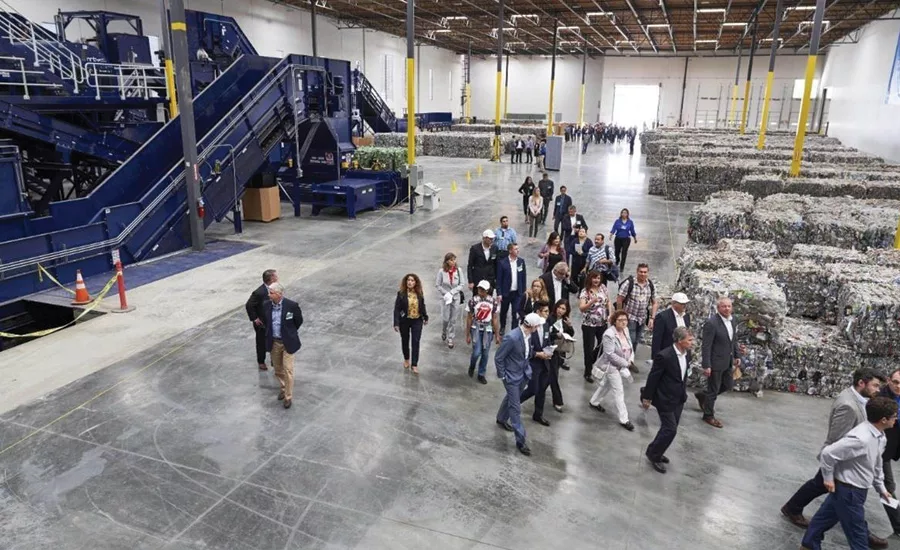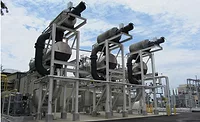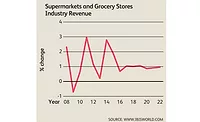Sustainability a cornerstone for beverage plants
Companies adopt water reuse, recycled materials and zero-waste practices

Built in conjunction with Woodard & Curran, the rPlanet Earth PET recycling facility takes curbside bales of used PET bottles and processes them into rPET flake where it is further transformed in the plant to rPET preforms used by Coca-Cola, Pepsi and Nestlé Waters to manufacture plastic bottles, Lloyd Snyder says. (Image courtesy of Woodard & Curran)
Energy efficiency, recyclability and environmental change are more than buzzwords in today’s changing consumer and societal landscape. In fact, the smart building market is projected to grow from $60.7 billion in 2019 to $105.8 billion by 2024, at a compound annual growth rate (CAGR) of 11.7 percent from 2019 to 2024, according to Reportlinker.com’s “Smart Building Market by Component, Solution, Services, Building Type, Region – Global Forecast to 2024” report.
The rising adoption of the Internet of Things (IoT)-enabled building management systems, an intensifying awareness of space utilization and increased adoption of industry standards and regulations are expected to drive growth of the smart building market across the globe, the report states.
The energy management segment is expected to experience the fastest growth rate, while the Asia Pacific (APAC) smart building market is projected to grow at the highest CAGR during the forecast period, according to the report. For instance, China has invested heavily in more than 2,500 building projects and Singapore is aiming for 80 percent of its buildings to be certified as “green” by 2030.
Lloyd Snyder, senior vice president at Portland, Maine-based Woodard & Curran, defines a sustainable facility as “one that produces their products in a manner that is favorable to sustaining the world (replenishment, efficiency and reuse of materials and energy).”
Sustainable facilities must employ many other eco-friendly strategies like reduced energy consumption and sustainable material practices, Snyder says.
“We see beverage plants focused on water reuse, recycled materials and waste minimization. Sustainable energy (solar) does play a part but much less significant,” he explains. “Water reuse can include treating, collecting and wastewater and rainwater harvesting and treatment. Waste minimization has been two-fold, using recycled material in their container manufacturing or looking for innovative packaging designs that use less materials. Within the production processes, more efficient equipment can often translate to less material loss and greater material efficiency.”
Snyder notes that 90 percent of beverage companies are trying to achieve some degree of a sustainable facility as compared with less than 25 percent 15 years ago. He attributes this to three main things: consumers are more conscious of the environmental impacts of the products they buy; governments are creating incentives for sustainable production; and higher energy and raw material costs are prompting companies to look for waste minimization, energy efficiency and water efficiency, he says.
A zero-waste model
Many companies also are focused on adopting a “zero waste” motto, which can be a subset of an overall sustainable facility strategy. “A zero-waste facility does not discharge materials to the land or water,” Snyder explains. “For instance, a beverage facility with a wastewater treatment process generates sludge. This sludge is often landfilled, but in a zero-waste facility, this sludge is used as a beneficial material such as a soil amendment.”
Sustainability has become a priority for beverage plants, flavor and ingredient companies, and distilleries. For instance, spent grains, wastewater and energy are some of the byproducts that Victoria Distillers, Victoria, British Columbia, produces when making its Empress 1908 Gin, Master Distiller Peter Hunt noted. Yet, in an effort to combat the excessive use of energy, the distillery runs on an ocean-based geothermal energy system for cooling during distillation.
Instead of dumping excess hot water down the drain, the geothermal system provides more than 1 billion BTUs of heat to the adjacent Sidney Pier Hotel & Spa for eight months of the year,” Hunt said. “Through the geothermal system, Victoria Distillers saves the island 3 million liters of water each year,” Hunt said in a statement.
Additionally, in October, Wauconda, Ill.-based Synergy Flavors Inc. completed a two-story, 38,000-square-foot office building designed with sustainability in mind. The company achieved LEED (Leadership in Engineering and Environmental Design) Gold certification on the project, which included the installation of solar panels on the roof as an on-site source of renewable energy; the use of native private-style species in the landscaping to eliminate the need for permanent irrigation; and the addition of bike racks and fuel-efficient preferred parking spaces.
From an architecture perspective, Jack Holleran, president at St. Louis-based HDA Architects, notes that building beverage plants with sustainability features continues to grow in prominence.
“Our clients are very interested in reducing operating cost,” Holleran says. “The best way is with energy efficiency in mechanical systems design, lighting selection (LED), building envelope R-values, vertical dock levelers, water conservation, systems controls and solar power. … ROI can be as little as two years. Our clients look at a five- to seven-year ROI to justify the cost.” BI
Looking for a reprint of this article?
From high-res PDFs to custom plaques, order your copy today!





